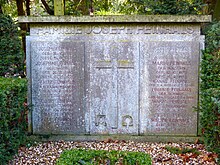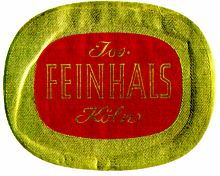Josef Feinhals (entrepreneur)
Joseph Feinhals , also Josef Feinhals , Latinized called Collofino (born December 31, 1867 in Cologne ; † May 1, 1947 at Randegg Castle , Hegau ) was a German entrepreneur (tobacco dealer), art patron and collector from Cologne. He was an initiator and promoter of the Rhenish and Cologne art and culture scene
Life
His parents were Joseph (1835–1907) and Josephine Feinhals, b. Hagen (1840-1921). On September 15, 1861, both of them opened an exclusive shop for tobacco and smoking supplies at Hohe Straße 6 (Unter Pfannenschläger), the first German shop of its kind with over 1000 varieties. One of her two sons was Joseph Feinhals. He studied political economy in Geneva , did an apprenticeship in a cigar factory in Bremen between 1887 and 1889 and then went to cigar factories in Cuba and New York City . His younger brother, the opera baritone Fritz Feinhals , decided early on to pursue a career as a singer and was not interested in his parents' business. In 1897 the father made the older son a partner in the company, in 1907 he became the boss. The mother continued the business as a widow from 1907 and passed it on to her son Joseph as sole owner in 1911.
After the old building on Hohe Straße was demolished in 1889, the move to the magnificent new building built by Kayser & von Groszheim on the corner lot on Hohe Straße 63 / Schildergasse took place on June 28, 1890 . Here he became one of the first German dealers to bring Havana cigars onto the market. Its shop windows were one of the city's artistic attractions. From around 1903 he became a royal Bavarian purveyor to the court . His business success enabled him to build a magnificent villa with Doric colonnades in the villa colony of the Cologne district of Marienburg , Lindenallee 3, which was completed in 1909 based on designs by Joseph Maria Olbrich (building), Max Laeuger (garden) and Bruno Paul (interior design).
At the end of February 1909 he met Hermann Hesse , who was reading from his works in the Düsseldorfer Schauspielhaus.). A lively correspondence developed between the two of them. Hesse stayed at the Villa Feinhals for a reading in January 1914 in Duisburg. Hermann Hesse lets Feinhals appear several times as "Collofino", namely in his stories Klingsor's Last Summer (1919), Die Morgenlandfahrt (1932) and in his 1943 novel Das Glasperlenspiel . This literal Latinization of the name Feinhals did not come from Hesse, but appears in the smokers' song " Munkepunkes Saturnalien" by Alfred Richard Meyer. In 1910, Bruno Paul created the family grave in the Melaten cemetery in Cologne . In 1912 Feinhals had him design the interior of his office at Hohe Strasse 59-61.

Art patrons and sponsors
Feinhals became a key figure in Cologne's cultural life. As a patron he sponsored Otto Freundlich , who created the mosaic The Birth of Man for his sponsor in 1919 . It was originally intended for the Villa Feinhals, but is now installed in the foyer of the Cologne Opera . Under his pseudonym “Collofino” he published works such as “The Tobacco in Art and Culture”, prose in “The Stories of Collofino” (1918) or humoresques in “Non olet” (It doesn't stink; 1939). The "Collofino panaceae magus Coloniensis" (the magician with the magic herb from Cologne) also sold a cigar brand called "Collofino". Feinhals was co-founder and 2nd chairman of the Sonderbund Westdeutscher Kunstfreunde und Künstler , member of the board of trustees of the Cologne Werkschulen and the State University of Music , honorary chairman of the Central Rhine group of the German Werkbund and initiated large art exhibitions in Cologne (1906 and 1907 in the Flora , 1912 Sonderbund Exhibition, 1914 exhibition of the German Werkbund). Josef Feinhals died in Randegg Castle in 1947 and - like his brother Fritz - was buried in the family crypt at the Melaten cemetery in Cologne .
Works
- Prose:
- 1918: The Stories of Collofino: A collection of strange incidents and puzzling adventures ...
- 1918: The Secret of the Marchesa or Giorgione da Castel Franco
- 1925: School memories, a fun school area
- 1939: Non olet or the cheerful table discussions of Collofino
- Technical literature:
- 1911: Tobacco in art and culture
- 1914: Tobacco anecdotes, a historical brown book
- 1915: Tobacco in the war
- 1936: About tobacco. A walk through the smokers' paradise
Individual evidence
- ↑ Konrad Feilchenfeldt (Ed.): German Literature Lexicon - The 20th Century. Volume 8, 2005, Col. 348.
- ^ Commissions-Verlag at A. Bagel, Die Rheinlande , Volume 11, 1911, p. 396.
- ^ Michael Limberg (ed.): Author evenings with Hermann Hesse. A documentation. Norderstedt: Books on demand, 2016, p. 41.
- ↑ Konrad Feilchenfeldt (Ed.): German Literature Lexicon - The 20th Century. Volume 8, 2005, Col. 347.
- ^ Hermann Hesse: Collected Letters: 1936–1948. 1982, p. 44 (FN 7)
- ↑ Martin Pfeifer: Explanations on Hermann Hesse's novel "Das Glasperlenspiel". 1977, p. 111.
- ↑ Gerhard Kolberg, Helga Behn: The Expressionists. 1996, p. 285.
- ^ Ulrich S. Soénius, Jürgen Wilhelm: Kölner Personen-Lexikon. 2008, p. 151 f.
| personal data | |
|---|---|
| SURNAME | Feinhals, Josef |
| ALTERNATIVE NAMES | Feinhals, Joseph; Collofino |
| BRIEF DESCRIPTION | German entrepreneurs (tobacco traders), art patrons and collectors |
| DATE OF BIRTH | December 31, 1867 |
| PLACE OF BIRTH | Cologne |
| DATE OF DEATH | May 1, 1947 |
| Place of death | Randegg Castle , Hegau |


